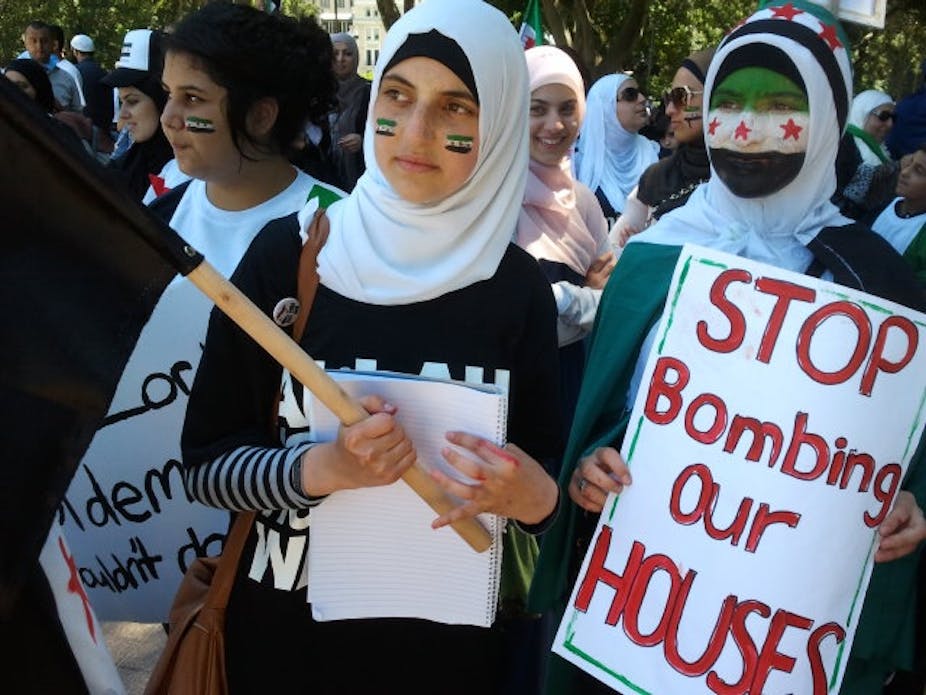In Syria, the optimism which accompanied the Arab Spring uprising has faded into the reality of a bloody sectarian civil war. Recent media reports have highlighted the involvement of foreign fighters in the conflict, including a number of Australians.
The effect of the violence is also being felt among Australian diaspora communities. However, while concerns regarding the participation of Australians in the fighting are legitimate, it is important to keep these fears in perspective.
Foreign fighters
As the Syrian protest movement merged with a loose network of defecting soldiers from the Assad military to form the Free Syrian Army, the opposition became increasingly murky, divided and sectarian.
In January of this year, signs emerged that jihadists had also begun to align themselves with the patchwork of Syrian opposition forces and there has since been the creation of a new jihadist organisation in Syria called Jabhat al-Nusrah (The Victory Front).
Jabhat al-Nusrah has since claimed responsibility for more than 200 attacks including bombings, assassinations and summary executions. These jihadists have been able to obtain arms courtesy of the intermediaries’ used by countries such as Saudi Arabia and Qatar to distribute weaponry.
With an increase in jihadists has also come an increase in foreign fighters, particularly from surrounding countries such as Lebanon, Jordan and Iraq. Estimates place the number foreign fighters in Syria between 1,100 and 2,700, including a number of Westerners. These include “tourists” wanting to join or assist in the fighting, individuals with familial ties to the region and experienced foreign jihadists from places like Iraq.
Australia
The Australian Federal Police have issued a formal warning to Australians not to take part in the fighting, stating that it is illegal. However, this warning has not stopped the involvement of a small number of Australians in some capacity.
Indeed, Syrian and Lebanese Australians are travelling to the region in what appear to be growing numbers. Estimates of the number of Australians involved have varied between half a dozen and 300; however the most realistic assessment was given by Mohammad al Hamwi of the Australian Syrian Association, who estimates the number to be around 80.
Though the majority are likely involved in assisting humanitarian efforts, there are increasing reports of as many as several dozen Australians now participating in the fighting.
This includes Marwan al-Kassab, reported by local media to have been killed in an explosion while manufacturing weapons for Syrian rebels.
An Australian Sunni Sheikh known to counter-terrorism authorities was also killed in a rocket attack. There have been conflicting reports as to whether the Sheikh was providing humanitarian assistance or participating in the fighting (with one report naming him as a platoon leader). Victorian kick-boxer Roger Abbas was also killed in the conflict several weeks ago.
The Australian-Lebanese connection
Lebanese Australians in particular are known to have travelled to the region. Many of these individuals have family connections in and around the northern Lebanese city of Tripoli and have crossed into Syria in solidarity with its Sunni majority.
Tripoli is less than 40km from the Syrian border and while there is a line on the map separating the states, northern Lebanese and southern Syrians effectively form one community. Though Lebanon has not traditionally been a primary theatre for the jihadist movement it is home to several capable jihadist networks. These groups have dissimilar agendas and are relatively small and clandestine semi-autonomous entities with informal organisational structures.
However, northern Lebanese jihadists have become increasingly active in Syria, working with elements of al Qaeda in Iraq under the banner of Jabhat al-Nusrah. The presence of Australians among these elements is not entirely unexpected as there have been several previous instances of Australians participating in jihadist activity in Lebanon. In the past ten years, 13 Australians have been arrested or charged in absentia for alleged involvement with Lebanese jihadist groups Fatah al-Islam and Asbat al-Ansar. Three others have also been arrested in separate jihadist-related incidents.
The domestic impact
Over the past year, a number of Australian protests associated with the conflict have involved the use of violence. This included a demonstration which ultimately intruded into the Syrian Embassy in Canberra.
Indeed, violence associated with the conflict is on the rise and includes a shooting in Sydney’s west, and a prayer room and cultural centre being set on fire in Melbourne.
Sectarian tensions also manifested recently in Melbourne when a group of Salafi men attacked an Alawite shop owner. The group, armed with knives and a gun, confronted the Alawite man and told him, “We’re going to shut you down, you Alawite dog”.
Additionally, Sydney police were forced to intervene after teenagers were found circulating mobile phone footage purporting to show regime forces burying a man alive. Such instances demonstrate the very real impact that the conflict is having in the Australian community. Counter-terrorism officials are also legitimately concerned that Australians involved in the Syrian conflict may return with skills and training which could be applied here.
The number of jihadists in Syria remains relatively small and if progress can be made in lessening the intensity of the fighting there is still an opportunity to prevent large numbers of foreign fighters entering the conflict.
But in the absence of a peaceful resolution, the number of jihadists will continue to grow, the Syrian people will continue to suffer and tensions will continue to manifest among diaspora communities.

